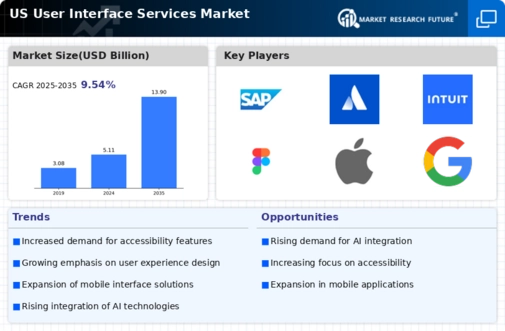Emphasis on Accessibility Standards
The user interface-services market is increasingly focusing on accessibility standards, driven by a growing awareness of the need for inclusive design. As regulations and guidelines evolve, businesses are compelled to ensure their digital products are accessible to all users, including those with disabilities. By 2025, it is estimated that 30% of user interface services will prioritize compliance with accessibility standards, reflecting a significant shift in design philosophy. This trend not only enhances the user experience for a broader audience but also positions companies as socially responsible entities. The user interface-services market is thus adapting to these demands, leading to the development of innovative solutions that cater to diverse user needs while adhering to legal requirements.
Increased Investment in UX Research
The user interface-services market is witnessing a marked increase in investment in user experience (UX) research, as organizations recognize the critical role of understanding user behavior in design. By 2025, it is anticipated that companies will allocate up to 25% of their design budgets to UX research initiatives. This trend underscores the importance of data-driven design decisions, enabling businesses to create interfaces that resonate with their target audiences. The user interface-services market is adapting to this shift by offering comprehensive research services that inform design strategies. As a result, organizations are better equipped to develop user-centric interfaces that not only meet but exceed user expectations, fostering greater loyalty and satisfaction.
Growth of Mobile and Web Applications
The proliferation of mobile and web applications significantly influences the user interface-services market, as businesses increasingly recognize the importance of optimizing their digital presence. With mobile app usage projected to reach 3.7 billion users by 2025, the demand for specialized user interface services is expected to rise correspondingly. Companies are investing heavily in user interface design to ensure their applications stand out in a crowded marketplace. This trend is particularly pronounced in the tech and retail sectors, where user interface-services market players are tasked with creating responsive and engaging designs that cater to diverse user needs. As a result, the market is likely to see a surge in innovative design solutions that enhance user interaction and satisfaction.
Integration of AI and Machine Learning
The integration of artificial intelligence (AI) and machine learning technologies into user interface design is reshaping the user interface-services market. These technologies enable the creation of adaptive interfaces that can learn from user behavior and preferences, thereby enhancing personalization. In 2025, it is projected that 40% of user interface services will incorporate AI-driven features, reflecting a growing trend towards intelligent design solutions. This shift not only improves user engagement but also streamlines the design process, allowing for more efficient iterations. The user interface-services market is thus evolving to accommodate these advancements, as businesses seek to leverage AI to create interfaces that are not only functional but also predictive of user needs.
Rising Demand for Intuitive Interfaces
The user interface-services market experiences a notable surge in demand for intuitive interfaces, driven by the increasing need for seamless user experiences across various digital platforms. As businesses strive to enhance customer satisfaction, the focus on user-friendly designs becomes paramount. In 2025, it is estimated that 70% of companies prioritize user experience in their digital strategies, indicating a significant shift towards prioritizing usability. This trend is particularly evident in sectors such as e-commerce and mobile applications, where user retention is closely linked to interface design. The user interface-services market is thus witnessing a transformation, as organizations invest in services that facilitate the creation of interfaces that are not only visually appealing but also easy to navigate, ultimately leading to improved customer engagement and loyalty.





















Leave a Comment